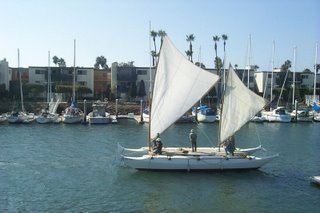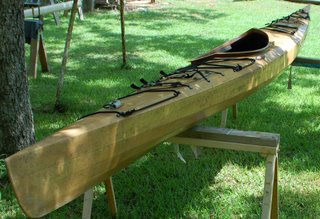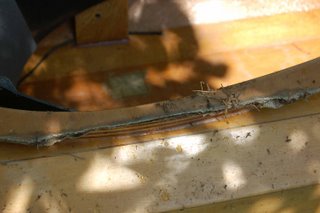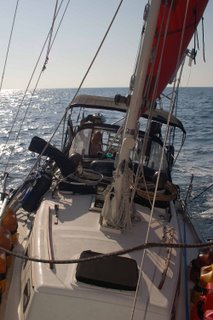Wednesday, January 31, 2007
Tiki 26 Construction has Begun!
Wednesday, December 06, 2006
Time to Move On
 Segundo Vez with her new owners, Houston and Bill Barker of Colorado, Nov. 2006
Segundo Vez with her new owners, Houston and Bill Barker of Colorado, Nov. 2006Wharram's Tiki range of catamarans certainly seemed to fit the bill, and at the time my interest was certainly more geared to smaller boats, so from his many sizes offered I picked the Hitia 17, a simple plywood beachcruiser that could be easily disassembled for trailering and could take me places faster than any kayak. I began the project hopeful that I could complete it in the 250 hours projected by the designer, but like most boatbuilders, I found that I needed twice as long to achieve a finished boat.
After a year of part-time boatbuilding, including building several smaller boats for paying customers, I launched Segundo Vez (Second Time) on the Gulf coast and found that at last I had a boat that was both simple and shallow draft, and could sail well to windward and at a good speed.
I took another road trip to Florida, this time to Tampa, where my brother lived, and cash in hand began visiting first hand many of the boats I'd found in the ads. Most of them were misrepresented and overpriced, but one, a 1968 Grampian 26 that the owner had begun restoring, appeared to be just right, and at a reasonable price. It was certainly big enough to live aboard, and a test sail proved it to be weatherly and easy to handle. I bought it and sailed it home single-handed, spending over a week enroute as I made my way along the Gulf coast.
Owning and sailing a 26-foot monohull with over 4 feet of draft was a new experience for someone coming from a sea kayaking background. I found myself limited as to where I could go, but the necessity to always know one's position when piloting this type of craft taught me a lot about seamanship and navigation. This boat also taught me a lot about boat restoration and refitting, and over time I rebuilt the interior and gradually outfitted the boat for cruising. I later got married on board and cruised south to the Florida Keys and the east coast of Florida with my then-wife and stepdaughter. Although most of this cruise was great, I once again found myself longing for a shallow-draft boat, especially when a Category 4 hurricane threatened the Keys and we found few options for places to go to secure the boat. We were lucky that storm turned when it did.
A few months later, my short-lived marriage ended, I sailed back to Mississippi with the help of a good friend and once again considered resuming the building of my Tiki 26. But I also had a lot of time and money invested in the Grampian, and I needed a boat I could comfortably live on, at least part time, as I was starting my marine carpentry business on the Gulf coast and needed a base there. I decided to keep the boat, as I could not sell it for what I had invested. I hauled out and completely repainted it, changing the color and then re-christening the boat Intensity to get rid of all the bad karma brought aboard by an ex-wife who really had no intention of staying anyway.
I sailed Intensity locally on the Gulf coast for three more years. One of the nicest things about owning a larger boat than a kayak or small open boat is the opportunity to introduce sailing to people who otherwise would never experience it. I always enjoyed taking friends and family members on day trips or short overnight cruises to the nearby barrier islands. But beginning in 2004 hurricane threats began to become more serious and more frequent, and I found myself constantly worrying about where I was going to take my boat to secure it in a storm. Finally in 2005, after riding out Tropical Storm Cindy on board and a near miss with Hurricane Dennis, which turned to north Florida, I found myself with no good place to go when Hurricane Katrina set her course for the Mississippi coast. I lost the boat, like so many of my other fellow sailors in the area, but I was determined to keep sailing.
Even before Hurricane Katrina, I knew about a Wharram Tiki 21 catamaran that was for sale in Ocean Springs, so I called the owner and found that the boat had survived, as it had been moved inland on a trailer. I purchased it shortly thereafter, and took it home for what would prove to be a longer than anticipated refit, see: http://tiki21element.blogspot.com
I wanted the Tiki 21 because it had more weight-carrying capacity than the Hitia 17, as well as two very minimal bunks, one in each hull. It' s not by any stretch of the imagination a good liveaboard vessel, but it has been proven to be exceptionally seaworthy, and a modified version was sailed around the world by Rory McDougal. I knew when I bought it that it would not be a long-term solution to my sailing needs, but I wanted to try a larger Wharram and thought it would be suitable for some smaller adventures while I made up my mind about another cruising boat.
During the long refit process, I spent more time than ever researching boat design, exploring many possibilities in boats I could build or purchase used and refit. I looked at catamarans, trimarans, and monohulls, and made two trips to Florida to look at examples that were for sale. The brilliant simplicity of the Wharram Tiki design kept me coming back to this range of boats, however, and as I rebuilt Element, I figured that another Wharram was in my future. I just wanted to be sure I was making the right decision this time, as I didn't want to keep going through the process of building/rebuilding but hopefully one more time.
Finally, several things converged at nearly the same time to aid in my decision process. I had a prospective buyer for Segundo Vez, so it could be sold, freeing up my work space for building a boat and adding some cash to the construction fund. Element was complete, and at last I had two options on the coast for docking her, so I would have a boat in the water, ready for quick weekend getaways when I needed a sailing fix or got disillusioned with building. I had long ago sold my Tiki 26 plans, but I knew of a new, unused set owned by another Tiki 26 sailor who had planned to build but then bought a used Tiki 26, so no longer needed the plans, so I got a deal on those. And, I found inspiration on the web from another experienced monohull sailor, Thomas Nielsen, who recently sold his deep-draft boat and opted to build himself a Tiki 26, documenting the process with his excellent blog: http://tiki26.blogspot.com/
All these things seemed to be leading in the right direction. Now, Element is in the water in Biloxi, Segundo Vez is at home with her new owners in Colorado, and I have my plans for Tiki 26 number 341, which will become Element II over the course of the next year or two. I'll be picking up the Okoume plywood for the build in a few days, and sometime shortly after the construction will begin.
Thursday, October 19, 2006
The New Age of Sail
In the article entitled "The New Age of Sail" by Dmitry Orlov, the author makes a case for the sailboat as mankind's greatest invention and explores the possibilities of the simple sailing vessel's role in the future as a vehicle and lifestyle of choice. Here's a quote from his accessment of the modern yacht style of sailboat, in his section The Sorry State of Sail:
"None of the sailboats currently in commercial production will do at all. Since the end of the age of sail, sailing has been relegated to a number of niches, none of them of much practical value. Overall, they have become a luxury item. An important element of this luxury is the freedom from the buzz or throb of the engine, the stench of fuel, and the noxious fumes of the exhaust plume: freedom to enjoy nature without assaulting it. An early application of steam power was in powering sailboats out of doldrums, but steam sailboats were quickly supplanted by steamboats that did not carry sail. A similar fate awaits the many modern sailboats that are designed to rely on their diesel or gasoline auxiliaries, but for the exact opposite reason: they will be trapped in the permanent doldrums of fuel scarcity.
The particular applications still reserved for sail include recreation, sport, and historical preservation, with dollops of luxury thrown in for each one. Recreational vessels range from small sailing canoes and dinghies to daysailers and small coastal cruisers. Sport encompasses a wide variety of racing boats, which are designed for speed, especially speed to windward. Historical preservation includes various old sloops and schooners, as well as newer boats constructed entirely of wood by master craftsmen. The realm of pure luxury gives us an assortment of cabin cruisers, which often have plenty of teak and mahogany paneling and trim, fancy navigational electronics, on demand hot water, and a sound system. Although they are capable of crossing oceans, they are mainly used for ostentation, to motor around the harbor, and to throw dockside parties. "
He goes on to further examine the simple requirements for living and traveling on the sea as in this excerpt from A Reasonable Set of Requirements:
The author goes on to describe his idea of the perfect boat to fit these requirements, basically the sharpie type and in particular some of the works of naval architect Phil Bolger. I am also an admirer of the sharpie type, especially some of the Parker designs, and I have built two dinghies designed by Phil Bolger and have sailed quite a bit on one of his open sharpie daysailor designs built by my brother. But to me the one limitation of most sharpie designs is ultimate, ocean crossing seaworthieness, and most sharpie designers state that their boats are designed for coastal and protected waters rather than long bluewater passages.
Needless to say, Wharram catamarans, built of wood with simple tools and basic skills, and a design incorporating maximum seaworthieness based on proven design principles also fit the author's requirements, though he might not be aware of them. Anyone interested in building and sailing their own boat will enjoy reading the entire article here:
http://www.culturechange.org/cms/index.php?option=com_content&task=view&id=67&Itemid=1
Wednesday, October 18, 2006
Glenn Tieman's "Child of the Sea" Launched


(photos courtesy of Bill Barker, who attended the launching)
One of James Wharram's newer catamaran designs, the ethnic "double canoe" he calls Tama Moana, or "Child of the Sea" was launched recently near Santa Barbara, California. Here's Wharram's description of the design:
The Child of the Sea has the traditional hullshape of the islands of Tikopia and Anuta. She is built in strip planking over plywood backbone and bulkheads. She is steered with side rudders. Ethnic Designs as Canoe Craft have a basic design principle of maximum boat for minimum cost, and at the same time be a research participant in a major attempt to recover and preserve the practical, design, handling aspects of Man's first offshore sailing vessels.
Length Overall:
37' 9"
11.5 m
Beam Overall:
14' 11 "
4.55 m
Weight:
3.525 ton
1600kg
Glenn Tieman, the builder is a long-time Wharram catamaran enthusiast and experienced sailor. His first Wharram catamaran was the Pahi 26 design, which he built himself and sailed all over the south Pacific, living aboard it for 10 years. Glenn is definately a minimalist who appreciates the simplicity and function of Wharram's designs, so the Tama Moana design with its traditional crab claw rig and spartan accomodations is right in line with his needs as an adventurous sailor who will soon set off to return to the Pacific islands on his new boat. He has christened his vessel "Manurere," Maori for "Bird on the Wing."
Glenn is to be commended for building such a fine example of the Tama Moana, and for having the courage to sail in a simple, yet seaworthy craft that is so far outside the mainstream of modern yachting. I wish him fair winds, following seas, and beautiful anchorages among the lonely atolls of Oceania.
Here's some more background info about the Tama Moana project from James Wharram's site:
http://www.wharram.com/lettermarch06.htm
Wednesday, August 09, 2006
Coho Kayak back for Repair and Refinishing


I built this Coho sea kayak from a kit by Pygmy Boats back in 1999 for my personal use. At about the same time, I also built the Pygmy Arctic Tern model, which is a hard-chined design, for my nephew Brian Nobles. I ended up selling the Coho in 2001 while I was off cruising in the Florida Keys aboard Intensity, the lucky buyer getting a great deal on a custom built wooden sea kayak because I needed cash at the time.
Brian eventually decided kayaking wasn't for him, so I bought the Arctic Tern back from him in 2003 and used it on trips such as the headwaters to the sea trip down the Pascagoula River that I did with Ernest Herndon. (For the book we wrote about this trip, go here: http://www.scottbwilliams.com/Pascagoula.html, the Arctic Tern is even on the cover.)
I never expected to see the Coho again, but last week the guy that bought it from me brought it over for repairs to a busted cockpit rim and general refinishing. I was glad to see that this boat has been used hard, as I built it extra strong for expedition paddling.
The cockpit damage was caused by driving into a too-low garage door opening with the boat on a roof rack. The owner ordered replacement parts in 4mm Okoume plywood from Pygmy Boats, so the repair would not involve fabricating any parts. I used a laminate trimming router with a panel-pilot bit to rip off the old coaming, and the new one has already been laminated on with epoxy. Next, I'll shape and glass it, then revarnish the decks and paint the hull from the sheer down. This boat has been scratched and gouged way too much for a decent varnish job on the hull, hence the paint. I think it will still look good, and will be ready for many more years of hard service.
The Coho and the Arctic Tern are both great boats, each weighing only 39 lbs., which is way lighter than any fiberglass or plastic kayak in the size range. They paddle exceptionally well, and track well without rudders, though having owned both I prefer the Arctic Tern for overall handling and tracking ability, especially in big waves or surf.
You can see my Arctic Tern here: http://www.scottbwilliams.com/Pygmykayaks.html
Or go to the Pygmy website and look at all the models they offer here:
You can buy the kit and build your own or hire a boatbuilder to do it for you. Pygmy boats are by far the best of the wooden kayak kits on the market, and all these kayaks are designed by John Lockwood, a serious kayaker with decades of experience who uses these boats on real expeditions.
Thursday, August 03, 2006
The Road of Life
Living several blocks inland from the beach in Gulfport, Jeff got literally "slabbed" by Katrina when the storm surge swept his house off it's concrete foundation and took away all of his family's worldly possessions. Jeff always has been a survivor though, and he has recovered from this loss remarkably fast, moving back to the coast and buying another house farther inland and completing this CD project he had started in early 2005.
You can read more about the Jeffery Williams story on his website, and even listen to clips from each of the 10 tracks on The Road of Life. Check it out here at: http://jefferytwilliams.com
Scott's Boat Pages Site Update
Most of my spare time this summer has been devoted to the extensive refit I've been doing on my Wharram-designed Tiki 21 catamaran, which will hopefully be ready to relaunch and sail about the time the worst of the hot weather here is over. Photos of the new paint job are posted on my other blog, which is devoted to this boat, at: http://tiki21element.blogspot.com/ The work I've done on this boat has included the full spectrum of boatbuilding crafts from woodworking and fiberglassing, to rigging and canvas work. It's been time consuming, but in the end I will have a practically brand new boat that will be ideal for exploring the shallow Gulf coast waters that are still filled with underwater hazards in the wake of Katrina that would make sailing a deep draft vessel chancy at best.
I've made some changes to the layout of the main website, and will soon publish several pages of photo galleries including images of the Mississippi coast both before and after Katrina, various other Mississippi nature photos, and travel and boating photos.
Monday, May 01, 2006
Life After Katrina
Life After Katrina: The Mississippi Gulf Coast in the Wake of a Major Hurricane.
This issue in bookstores now, for those who are interested. There are several photos in the article from the coast, some taken immediately after the storm and some taken a few months later when Travis Easley and I did some exploring in our sea kayaks.
Here's a link to the Sea Kayaker website: http://www.seakayakermag.com/
An Easy Gulf Passage

Artie Vaughan and Halcyon at Ft. Myers Beach Marina, FL
Note the new bowsprit and anchor platform that I built for the boat earlier this year, as well as the new bow pulpit Artie installed.
Artie Vaughan and I had an easy four-day passage across the Gulf from Biloxi to Ft. Myers Beach last week. We left Point Cadet Marina just before dark on Sunday night and made our landfall Thursday afternoon, and had the boat secured at a dock there before dark that evening.
The timing for the crossing worked out just right, as we stayed ahead of a cold front and a line of thunderstorms that was moving into the northern Gulf by Monday. For most of the passage, we enjoyed light winds out of the south, allowing us to sail on a close reach on our direct rhumbline to the southeast. Winds during the trip never exceeded 15 knots, and most of the time were less than 10, making it necessary to run the inboard Yanmar for assistance in maintaining our 5-knot average. Seas were about as gentle as could ever be expected for a period of four days on the open Gulf, averaging about 2-3 feet.

Dolphins in the blue water midway through the passage. There were about 25-30 of them in this group, cruising alongside and playing in the bow wave. This far out, the Gulf is Caribbean clear. At night our wake appeared as a trail of sparks due to heavy concentrations of bioluminescent plankton.

Halcyon is as great a boat as I suspected she was the first time I saw her when Artie arrived at Point Cadet two years ago. All Pacific Seacraft boats are well-built to the point of being over-built, and Artie has especially well-equipped this example of the Orion 27 model. The boat is ready to go practically anywhere on all oceans, with all systems in excellent order and good repair. A retired electrical engineer, Artie is meticulous in maintaining his boat, and in my opinion, wise in choosing a vessel of this size. Give me a well-found 27-footer designed for bluewater cruising any day over the 35-40+ footers that are so popular these days. A boat the size of Halcyon is easier to maintain, easier to handle, and a lot easier to buy and equip, while still being large enough to be comfortable and seaworthy.
Artie is going on from Ft. Myers to the east coast of Florida and then the Bahamas for a few weeks. I'm sure he's going to have a great cruise, and I'm envious of all that time he's going to get to spend sailing a great boat in warm, clear waters.

